- 3/4”(DN20)
- Full Bore
- 150LB
- F316
- Lever
- API 6D
- API598
- RF Flange
- ASME/ANSI B16.5
Specification
Cryogenic Liquids Manual Valve Refrigerants Cryogenic High Pressure Ball Valve
|
Valve Size |
1“–10” |
|
Pressure Class |
150LB–600LB, PN10–PN64 |
|
Materials |
WCB, A105, LF2, F316, WC6, WC9, WCC, CF8, CF3, CF3M, CF8M, 4A, 5A |
|
Design and Manufacturing Standards |
API 6D, API 608,ASME B16.34,ISO 17292,BS5351, |
|
Face to Face Standards |
ASME B16.10, BS 558, BS12982, ISO 5752 |
|
Flange Dimension Standards |
ASME B 16.5, ASME B16.47, ASME B16.25, ASME B16.11, BS 12627 |
|
Pressure Test Standards |
API598 API 6D BS12569 |
|
Fire Safety Test Standards |
API 6FA API 607 |
|
Quality/Product Certifications |
ISO9001, ISO14001, ISO18001 |
|
Fugitive Emissions |
ISO 15848-1, API 622 |
|
NACE |
NACE MR 0175 |
|
Valve operator options |
Handwhel, Worm Gear, Electric actuator, Pneumatic actuator, Hydraulic Actuator. |
|
Shutoff Class |
API 598 (Zero Leakage), API 6D |
|
Bore |
Full Bore, Reduced Bore |
|
Process Connection Types |
SW, NPT, BW , RF, RTJ |
Product Overview
1″~10″ 150LB~600LB F316 Cryogenic High-Pressure Manual Ball Valve
I. Product Overview
Newway cryogenic high-pressure manual ball valve is a specialized flow control solution engineered for extreme low-temperature and high-pressure systems handling cryogenic liquids and refrigerants. Built with F316 stainless steel and other high-performance materials (CF8M, LF2, etc.), it integrates a full-bore/reduced-bore design and API 6D compliance to ensure reliable shut-off and regulation of LNG, liquid nitrogen, refrigerants, and other cryogenic media. Operating across cryogenic temperatures (typically -196℃~150℃) and 150LB~600LB pressure, it balances low-temperature toughness, high-pressure resistance, and ease of manual operation. Ideal for LNG terminals, cryogenic storage, refrigeration systems, and chemical processing, it addresses the challenges of sealing and structural stability in extreme cold environments where standard valves fail.
II. Key Attribute Parameters
Size Range: 1″~10″ (DN25~DN250), covering small to medium-diameter pipelines for cryogenic fluid transfer and control.
Pressure Range: 150LB~600LB (PN10~PN64), adapting to low to high pressure systems such as LNG transfer lines and high-pressure refrigerant loops.
Temperature Range: -196℃~150℃, validated for stable operation in cryogenic conditions (liquid nitrogen, LNG) and moderate high temperatures (heated cryogens).
Material Configuration:
Body & Bonnet: F316 stainless steel (ASTM A182), with molybdenum alloying (2~3% Mo) for corrosion resistance and cryogenic toughness; optional CF8M (for general corrosives) or LF2 (for low-temperature impact resistance).
Ball & Stem: F316 with Stellite coating (hardness 55~60HRC), enhancing wear resistance and preventing cold brittleness at -196℃.
Seal: Metal-to-metal hard seal with cryogenic alloy (nickel-chromium-molybdenum) coating, retaining elasticity in extreme cold to avoid leakage.
End Connections: RF flange, RTJ flange, SW, NPT, BW (per ASME B16.5/B16.25), ensuring leak-tight integration with cryogenic pipelines.
Actuation: Manual (lever, handwheel, worm gear), with lever operation enabling 90° quick shut-off for emergency scenarios.
Design Standards: API 6D, API 608, ASME B16.34, ensuring compliance with global cryogenic and high-pressure valve specifications.
III. Features Description
Cryogenic-Resistant Structure: The valve body and internal components are manufactured from F316, which retains ductility at -196℃ (no brittle fracture) — a critical trait for LNG and liquid nitrogen systems where standard carbon steel would crack.
Metal-to-Metal Cryogenic Sealing: The ball and seat feature precision-lapped metal surfaces with a cryogenic alloy coating, maintaining a tight seal even as materials contract at low temperatures. This design achieves API 598 zero leakage, preventing dangerous cryogen escape.
Full-Bore Option: Full-bore design minimizes pressure drop, allowing unobstructed flow of cryogenic liquids — essential for LNG transfer, where pressure loss can cause vaporization and system instability.
Fire-Safe Compliance: Meets API 6FA/607 fire safety standards, with metal backup seats ensuring sealing integrity even if soft seals are damaged in a fire — a key requirement for oil & gas and chemical facilities.
Manual Operation Reliability: Lever and worm gear actuation are optimized for low-temperature use, with anti-icing features (e.g., stem heating jackets optional) to prevent freezing-induced jamming. The handwheel provides precise control for throttling in refrigeration systems.
IV. Manufacturing Processes
Material Validation: F316 forgings undergo Charpy impact testing at -196℃ to verify toughness (≥27J), ensuring resistance to cold-induced fracture. Ultrasonic testing detects internal defects that could fail under pressure.
Precision Machining: CNC turning centers machine the valve body and ball to tight tolerances (±0.02mm) to ensure uniform sealing contact. The ball’s sealing surface is lapped at -196℃ (cryogenic lapping) to simulate real-world conditions, preventing post-installation leakage.
Seal Coating Application: The metal seal is plasma-sprayed with a 100~150μm cryogenic alloy coating, then polished to Ra ≤0.4μm. This coating retains flexibility at extreme cold, avoiding cracking during thermal cycling.
Assembly & Testing:
Cryogenic Immersion Test: Valve is submerged in liquid nitrogen (-196℃) for 2 hours, then operated to confirm smooth rotation and seal integrity.
Hydrostatic Test: Body tested at 1.5×rated pressure (e.g., 900LB for 600LB class) with water; seats tested at 1.1×rated pressure to verify no leakage.
Helium Leak Detection: Post-assembly, helium testing at -196℃ ensures leakage rate ≤1×10⁻⁹ Pa·m³/s — critical for cryogenic safety.




